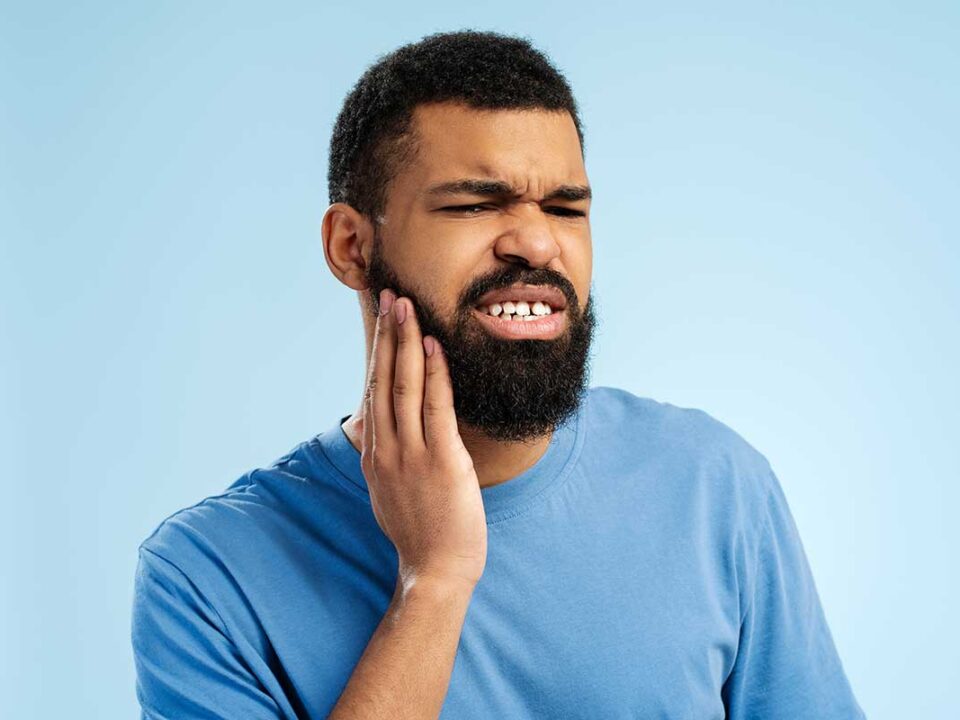Unfortunately, tooth pain is a common issue that can affect anyone, and as dentists we see a lot of patients suffering because of it. Tooth pain can range from mild discomfort to severe throbbing, it is often a sign that something is wrong. In our experience, most of the time it’s one of a handful of common reasons for tooth pain that is behind it and usually we can treat these issues fairly quickly. It’s never nice, and identifying the cause of tooth pain is crucial for proper treatment and prevention of further complications. We always recommend seeing your dentist asap, but for the meantime, we’ve compiled this article that explores ten common reasons for tooth pain and provides information on prevention, treatment, and when to seek professional help.
While this article is fact checked by our dental team, it is not intended as medical advice or to replace a visit to your dentist if something is wrong.
Let’s get started.
Table of Contents
Tooth Decay (Cavities)
Tooth decay, commonly referred to as cavities, occurs when plaque—a sticky film of bacteria—produces acids that erode the tooth enamel. If left untreated, decay can reach the dentin (the softer layer under enamel) or even the pulp, leading to intense pain.Symptoms:
- Sensitivity to hot, cold, or sweet foods and drinks.
- A persistent toothache that worsens when chewing.
- Visible discoloration, pits, or holes in the tooth.
Why It Happens:
Tooth decay often results from poor oral hygiene, a sugary diet, or dry mouth, which reduces saliva’s ability to neutralize acids.Prevention and Treatment:
Brushing twice daily with fluoride toothpaste, flossing, and regular dental checkups are essential to prevent decay. If cavities form, your dentist may recommend fillings, inlays, or crowns and a root canal or extraction in severe cases.Gum Disease (Gingivitis and Periodontitis)
Gum disease begins as gingivitis, a mild inflammation of the gums caused by plaque buildup, and can progress to periodontitis if untreated. In periodontitis, the infection spreads to the bone and ligaments supporting the teeth, leading to severe pain and potential tooth loss.Symptoms:
- Swollen, red, or bleeding gums.
- Persistent bad breath or a bad taste in the mouth.
- Painful, receding gums and loose teeth.
Why It Happens:
Poor oral hygiene, smoking, and certain medical conditions like diabetes can increase the risk of gum disease.Prevention and Treatment:
Preventive care includes proper brushing and flossing and routine dental cleanings. Advanced gum disease may require deep cleaning (scaling and root planing), antibiotics, or surgical interventions like flap surgery or bone grafting.Tooth Sensitivity
Tooth sensitivity arises when the protective enamel wears away, exposing the dentin and microscopic tubules leading to the tooth’s nerves. It can also occur due to gum recession exposing the tooth root.Symptoms:
- Sharp, sudden pain triggered by hot, cold, sweet, or acidic foods and drinks.
- Lingering discomfort after exposure to temperature changes.
Why It Happens:
Aggressive brushing, teeth grinding, acidic diets, and gum disease can all lead to sensitivity.Prevention and Treatment:
Using desensitizing toothpaste and soft-bristled toothbrushes can reduce sensitivity. For severe cases, fluoride treatments, dental sealants, or bonding may be necessary to protect exposed areas.Cracked or Broken Teeth
Cracks or fractures in teeth can range from minor enamel cracks to severe splits reaching the pulp. These issues often result from accidents, grinding, or biting down on hard objects.Symptoms:
- Pain when chewing or biting, especially when releasing pressure.
- Sensitivity to temperature changes or sugary foods.
- Visible cracks or chipped pieces.
Why It Happens:
Weakened enamel, trauma, or repeated stress can cause teeth to crack or break.Prevention and Treatment:
Avoid chewing ice or hard foods and wear a mouthguard if you grind your teeth. Treatment depends on the severity and may include bonding, crowns, root canals, or extractions.Abscessed Tooth
A dental abscess is a pocket of pus caused by a bacterial infection in the tooth root or surrounding tissue. It often results from untreated decay, injury, or gum disease.Symptoms:
- Severe, throbbing pain that may radiate to the jaw or ear.
- Swelling, redness, or tenderness in the gums.
- Fever, swollen lymph nodes, and a foul taste in the mouth.
Why It Happens:
Bacteria enter the tooth through cavities or cracks, reaching the pulp and causing infection.Prevention and Treatment:
Good oral hygiene can prevent abscesses. Treatment includes draining the abscess, antibiotics, root canal therapy, or, in severe cases, tooth extraction.Impacted Wisdom Teeth
Wisdom teeth, or third molars, often lack enough space to emerge properly, becoming impacted or partially erupted. This can lead to pain and infections.Symptoms:
- Persistent pain at the back of the jaw.
- Swelling, redness, and tenderness in the gums.
- Difficulty opening the mouth or chewing.
Why It Happens:
Wisdom teeth that grow at odd angles or fail to fully erupt press against neighboring teeth or the jawbone.Prevention and Treatment:
Regular dental X-rays can monitor wisdom teeth development. If impacted, extraction is typically recommended to prevent pain, infections, or damage to adjacent teeth.Grinding or Clenching (Bruxism)
Bruxism involves unconscious grinding or clenching of teeth, often during sleep. Over time, this can lead to tooth pain, sensitivity, and damage.Symptoms:
- Aching teeth and jaw pain, especially in the morning.
- Headaches and earaches.
- Flattened or worn-down teeth.
Why It Happens:
Stress, anxiety, or misaligned teeth are common causes of bruxism.Prevention and Treatment:
Stress management techniques and wearing a custom mouthguard at night can protect teeth. Severe cases may require orthodontic treatment or Botox to reduce jaw muscle tension.Sinus Infections
The roots of the upper molars are close to the sinuses, and sinus infections can cause referred pain that mimics a toothache.Symptoms:
- Pressure or pain in the upper teeth, jaw, and cheeks.
- Nasal congestion or a runny nose.
- Pain that worsens when bending forward.
Why It Happens:
Inflamed sinuses press against the upper jaw, causing discomfort.Prevention and Treatment:
Treat the sinus infection with decongestants, antihistamines, or antibiotics (if bacterial). Pain typically resolves once the infection clears.Dental Abscess or Infection Following Dental Work
Dental procedures like fillings, crowns, or implants can occasionally lead to complications, including infections.Symptoms:
- Persistent pain, swelling, or sensitivity after dental work.
- Fever or pus near the treated tooth.
Why It Happens:
Improper sealing of a filling or crown, or bacteria entering during a procedure, can lead to infection.Prevention and Treatment:
Follow your dentist’s aftercare instructions carefully. Return for adjustments or antibiotics if symptoms persist.Orthodontic Pain
Orthodontic treatments like braces and aligners work by applying pressure to teeth to move them into alignment, which can cause temporary discomfort.Symptoms:
- Soreness in teeth and gums after adjustments.
- Difficulty chewing or biting.
Why It Happens:
The pressure exerted by braces or aligners temporarily irritates the periodontal ligament.Prevention and Treatment:
Over-the-counter pain relievers, orthodontic wax for irritation, and following your orthodontist’s advice can help manage discomfort.When to See a Dentist
Tooth pain can sometimes be managed with home remedies, but certain symptoms require immediate attention from a dental professional. Knowing when to seek help is crucial to prevent further complications. Persistent or Severe Pain: Pain lasting more than 1-2 days, or sharp, throbbing pain that disrupts daily life, indicates a potential underlying issue like an abscess or severe decay. Swelling or Fever: Swelling in the gums, face, or jaw, combined with fever, could signal an infection that needs prompt treatment to prevent it from spreading. Visible Abscess or Pus: Signs of an abscess (a pocket of pus) near a tooth or gum line require immediate intervention. Trauma or Injury: Broken, cracked, or knocked-out teeth caused by an accident need urgent care to save the tooth or manage pain. Unresponsive to Pain Relievers: A dentist can provide targeted solutions if over-the-counter medications or home remedies don’t alleviate the pain. Unusual Pain in Surrounding Areas: Pain in the jaw, neck, or ear associated with tooth problems could indicate a more significant dental or sinus issue.Preventive Measures
Prevention is the best way to avoid tooth pain. Consistent oral hygiene practices and informed lifestyle choices can protect against most dental problems. Brushing and Flossing: Brush at least twice a day with fluoride toothpaste and floss daily to remove plaque and food particles that can lead to cavities and gum disease. Regular Dental Checkups: Schedule checkups every 6 months for professional cleaning and early detection of issues like decay or gum disease. Use Fluoride Products: Fluoride strengthens enamel and helps protect against decay. Consider fluoride mouthwash or toothpaste for added protection. Healthy Diet: Reduce sugary and acidic foods that erode enamel and feed bacteria. Eat a balanced diet with calcium-rich foods to support strong teeth. Avoid Tobacco: Smoking and chewing tobacco can increase the risk of gum disease, tooth loss, and oral cancer. Wear a Mouthguard: If you grind your teeth (bruxism) or play sports, use a custom-fitted mouthguard to prevent damage to your teeth.Home Remedies for Temporary Relief
While professional care is essential for diagnosing and treating tooth pain, these remedies can provide temporary relief: Saltwater Rinse: Dissolve 1/2 teaspoon of salt in warm water and swish it in your mouth. It helps reduce inflammation and clean the affected area. Cold Compress: Apply a cold compress or ice pack to the outside of your cheek for 15-20 minutes to reduce swelling and numb the pain. Clove Oil: Dab a small amount of clove oil on a cotton ball and place it on the painful tooth. Clove oil contains eugenol, a natural anesthetic and antiseptic. Over-the-Counter Pain Relievers: Use ibuprofen or acetaminophen to manage pain and reduce inflammation. Follow dosing instructions carefully. Hydrogen Peroxide Rinse: Dilute hydrogen peroxide with equal parts water and swish it in your mouth to kill bacteria and reduce discomfort. Tea Bag Compress: Use a cooled, wet peppermint or black tea bag on the affected area. Tannins in tea may reduce swelling and provide mild pain relief.Connection Between Tooth Pain and Overall Health
Tooth pain isn’t just a localized issue—it can signal broader health concerns or have systemic effects. Understanding this connection highlights the importance of dental health for overall well-being. Heart Disease and Stroke: Untreated gum disease (periodontitis) can increase the risk of cardiovascular issues. Bacteria from infected gums can enter the bloodstream, causing inflammation in blood vessels. Diabetes: People with diabetes are more prone to gum disease due to reduced immunity. Conversely, severe gum infections can make it harder to control blood sugar levels. Respiratory Infections: Bacteria from the mouth can be inhaled, leading to respiratory infections or exacerbating existing conditions like pneumonia. Pregnancy Complications: Hormonal changes during pregnancy can increase the risk of gum disease, which has been linked to premature birth and low birth weight. Jaw and Facial Pain: Chronic tooth pain or grinding (bruxism) can lead to temporomandibular joint (TMJ) disorders, causing headaches and jaw discomfort. Nutritional Impact: Tooth pain can affect eating habits, leading to poor nutrition and deficiencies that further impact overall health.Why Addressing Tooth Pain is Essential
Tooth pain, if ignored, can lead to serious complications, including: Tooth Loss: Untreated cavities, infections, or trauma can result in permanent loss of teeth. Infections Spreading: Dental infections can spread to the jawbone, sinuses, or bloodstream, causing life-threatening conditions like sepsis. Quality of Life Issues: Persistent pain can disrupt sleep, eating, and overall comfort, impacting daily life and productivity.If in doubt, seek professional help
Understanding tooth pain’s common causes and preventive measures are essential for maintaining optimal dental health. While home remedies provide temporary relief, professional care is critical to address underlying issues. Moreover, keeping up with regular dental visits not only protects your teeth but also contributes to your overall health and well-being. Don’t ignore tooth pain—it’s your body’s way of signalling that something needs attention!Check us out on Facebook and Twitter for daily information about Oral Health from Martindale Dental, or visit our offices in Hamilton, and St. Catharines.
Have more questions?
Please contact us for all inquiries or to book an appointment with one of our convenient clinic locations. We look forward to hearing from you.



